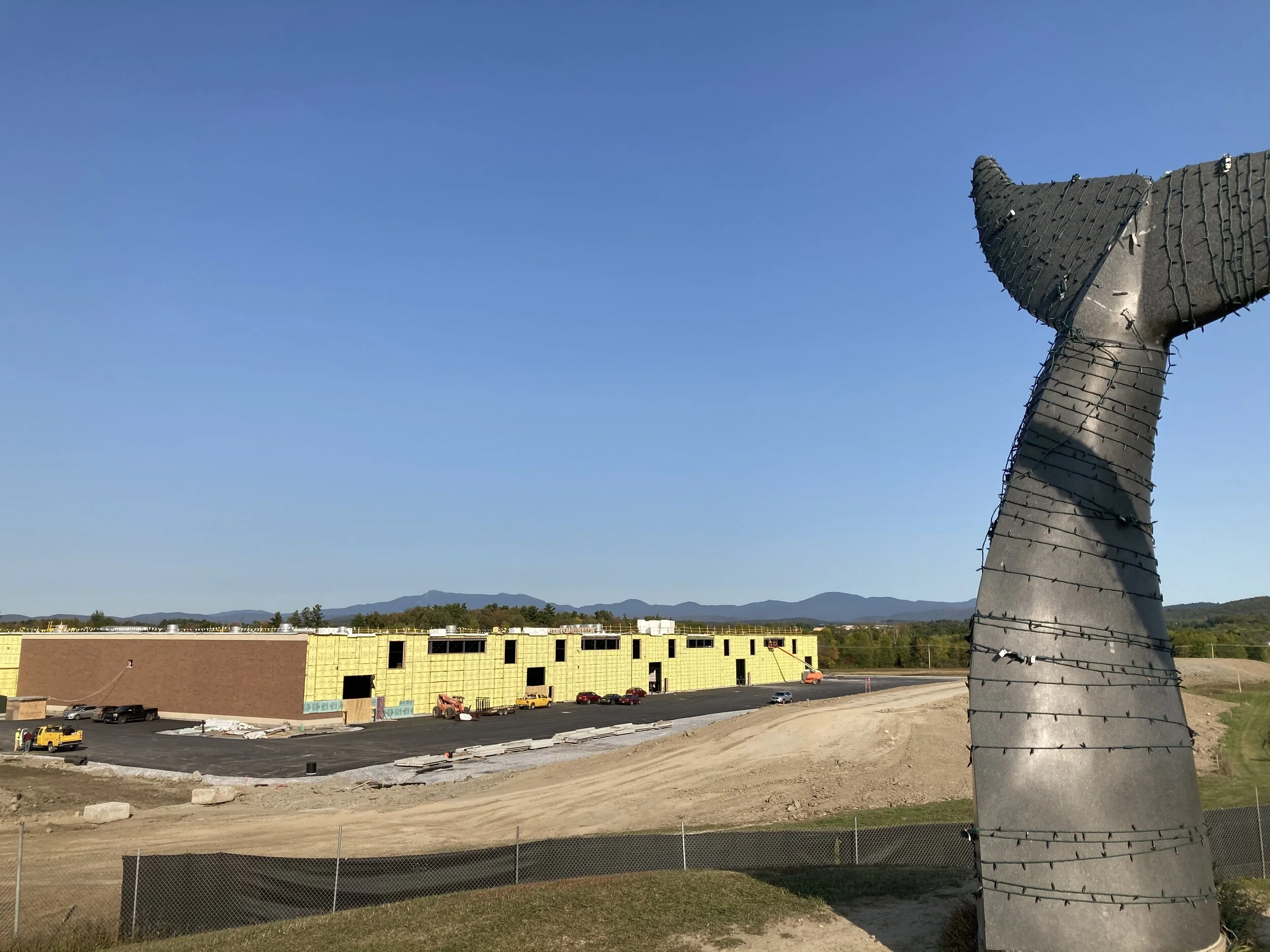New FedEx warehouse to pave over unprotected wetlands, install gravel replacement
FedEx warehouse from the Whales Tails vantage point just off I-89. Construction crews are installing artificial gravel wetlands to mitigate water damage to the adjacent Muddy Brook tributary. Photo by Aidan Scanlon.
A new FedEx warehouse, visible along I-89 from Williston and South Burlington, will use top-of-the-line water management practices to curb damage to the nearby Muddy Brook, a Lake Champlain tributary.
The FedEx building will be one of the largest in the area. Nearby Technology Park Center, which is 275,000 square feet, and Keurig Green Mountain Coffee, which is 228,000 square feet still dwarf the new FedEx hub, which measures in at 143,000 feet, according to plans submitted to the South Burlington Department of Planning and Zoning.
The warehouse sits between the Whales Tails sculpture next to I-89 and the Muddy Brook. The site takes up most of the meadow the sculpture was built in. The construction site is a stone's throw away from the sculpture itself.
About 18,000 square feet of class three wetlands — a class unprotected by Vermont’s wetlands rules — will be paved over during construction according to plans submitted to South Burlington’s Department of Planning and Zoning.
Eric Howe, program director of the Lake Champlain Basin Program said that the Muddy Brook has had issues with phosphorus, which could be worsened by development unless precautions are taken.
Phosphorus is in fertilizer, manure, and human or animal waste. Despite the lake’s flora needing the phosphorus for nutrients, too much of it can be harmful, causing algal blooms and excessive plant growth, according to the Lake Champlain Basin Program website. When these plants decompose they cause water quality issues that can be harmful to the fish and other organisms that rely on the lake for survival.
“Development across the Lake Champlain Basin actually contributes more phosphorus on a per acre basis than other land uses like agriculture or forested lands. So we do need to be aware of that as development pressures increase across the Lake Champlain Basin,” Howe said.
Even though the Muddy Brook won’t be directly impacted by the construction there are still concerns over stormwater. Technology Park is situated in between the Potash Brook and the Muddy Brook, both of which are important tributaries that feed into Lake Champlain.
David Wheeler, the Assistant Stormwater Superintendent at South Burlington Department of Public Works, said that large developments similar to the warehouse can have significant impacts on nearby waterways like the Muddy Brook.
“When you put pavement down you’re preventing water from soaking into the ground so it has to go somewhere. And so especially when you put in a bunch of catch basins and pipes and things like that you can get that water to move rather quickly,” Wheeler said. “So suddenly you can have a significant amount of water coming off the site where previously maybe the majority soaked into the ground.”
This increase in water runoff can cause small streams to swell to sizes they wouldn’t normally achieve. This causes the banks to erode which then further increases the amount of phosphorus in the water. A significant chunk of the phosphorus in the lake comes from streambank erosion, Wheeler said.
The other concern with stormwater runoff is build up of pollutants on surfaces like pavement.
“The best way to think about it is like the color of the snow on the road in the wintertime, brown and nasty compared to the white. That’s happening all year round you just don’t see it as much in the summer and fall and spring. That material that accumulates on impervious surfaces when it rains it all washes off,” Wheeler said.
The FedEx building was permitted under the most recent stormwater mitigation standards, and construction crews are installing two subsurface gravel wetlands, which are top-of-the-line in stormwater treatment practice, Wheeler said.
The subsurface gravel wetlands use a surface marsh, and a subsurface gravel bed to remove pollutants from the water. Phosphorus in the water absorbs into the stone, removing most of it from the water to make it safer for tributaries, Wheeler said.
This makes the impact of a development site much less than some existing buildings that don’t have stormwater treatment practices because they were built before these standards were in place, Wheeler said.








